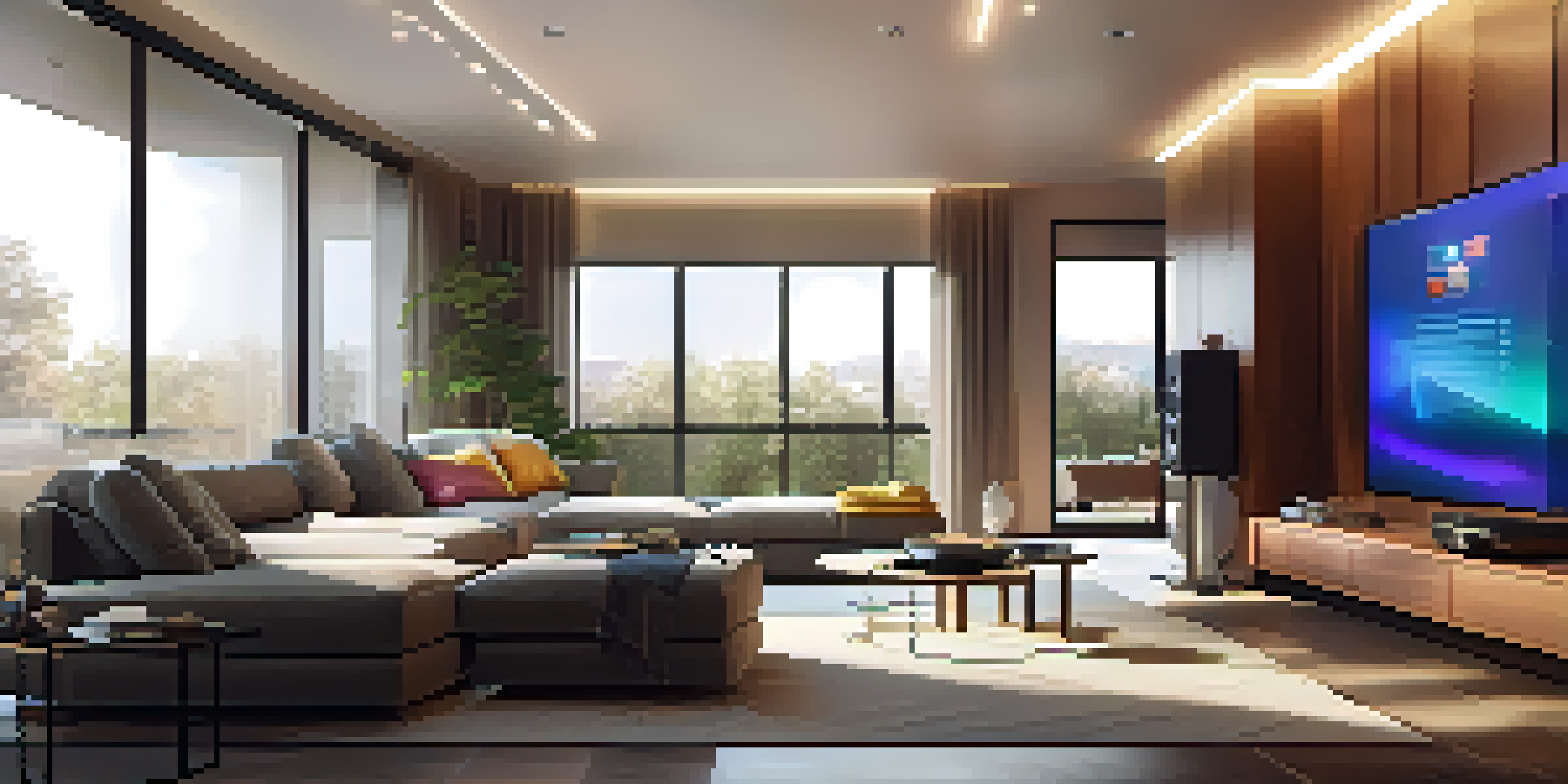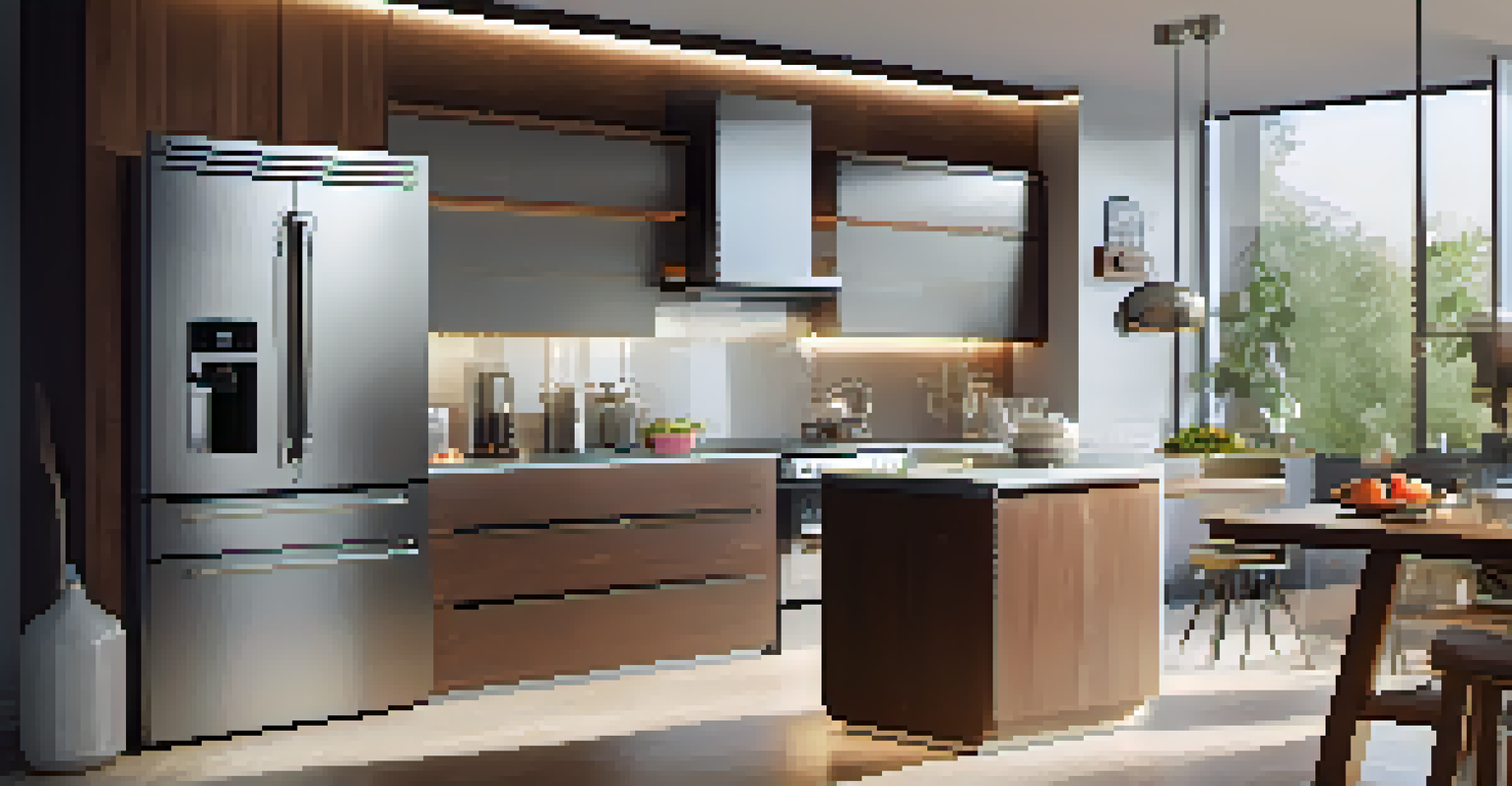Key Components of a Home Automation System Explained

Understanding Home Automation: A Brief Overview
Home automation refers to the use of technology to control various household systems and appliances remotely. Imagine being able to adjust your thermostat, lights, and security system all from your smartphone. This convenience not only enhances your lifestyle but also promotes energy efficiency and security. Essentially, it transforms your home into a smart living space, making everyday tasks simpler and more efficient.
The future is already here — it's just not very evenly distributed.
At its core, a home automation system connects devices through a central hub or network, allowing them to communicate with each other. This interconnectedness enables users to create customized routines that suit their lifestyles. For instance, you can program your lights to dim at sunset or have your coffee maker start brewing as soon as your alarm goes off. It's all about making your home work for you.
As technology continues to evolve, the possibilities within home automation are expanding. From smart speakers to surveillance cameras, the integration of various devices offers endless opportunities for customization. This article will delve deeper into the key components of a home automation system, helping you understand how each piece works to create a seamless experience.
Smart Hub: The Brain of Your Home Automation System
The smart hub acts as the central control unit for your home automation system. Think of it as the conductor of an orchestra, coordinating the different instruments—in this case, your devices—to create a harmonious living environment. Without a smart hub, your individual devices would struggle to communicate effectively, limiting their functionality.

Most smart hubs support various protocols, allowing them to connect with a wide range of devices. This means you can manage everything from smart lights to security cameras from one convenient app. A well-chosen hub can significantly enhance your system's flexibility, enabling you to add new devices smoothly as technology advances.
Smart Hub: Central Control Unit
A smart hub coordinates various devices in your home, ensuring they communicate effectively for a seamless automation experience.
Additionally, many hubs offer voice control capabilities, making it even easier to manage your home. Imagine walking into your house and simply saying, 'Turn on the lights,' and having it respond instantly. This convenience is just one of the reasons a smart hub is considered a critical component of any home automation system.
Smart Lighting: Brightening Your Space Intelligently
Smart lighting systems allow you to control the brightness and color of your lights remotely. Rather than relying solely on traditional switches, you can use your smartphone, tablet, or voice commands to create the perfect ambiance for any occasion. Whether it's a cozy movie night or a vibrant dinner party, smart lighting can set the mood effortlessly.
Technology is best when it brings people together.
Moreover, smart lighting can help you save energy and reduce costs. With features like scheduling and motion sensors, you can ensure that lights are only on when needed. For example, you can program your outdoor lights to turn on at dusk and off at dawn, providing both security and efficiency.
The ability to customize lighting scenes is another exciting aspect of smart lighting. You can create different settings for various activities, such as reading, entertaining, or relaxing. This level of personalization not only enhances your comfort but also adds a touch of sophistication to your home.
Smart Security: Keeping Your Home Safe and Secure
Smart security systems are designed to keep your home and loved ones safe. From video doorbells to motion-sensor cameras, these devices provide real-time monitoring and alerts, allowing you to keep an eye on your property remotely. Imagine receiving a notification on your phone whenever someone approaches your front door, giving you peace of mind while you're away.
Many smart security systems also integrate with other components of your home automation setup. For instance, you can program your security cameras to activate when you leave home, and have your smart lights turn on to simulate occupancy. This combination can deter potential intruders and enhance your overall security.
Smart Security for Peace of Mind
Smart security systems enhance your home’s safety with real-time monitoring and alerts, providing you with greater control and reassurance.
Additionally, features like smart locks enable you to control access to your home without the need for physical keys. You can lock or unlock doors remotely, grant access to guests, or even receive alerts when someone enters or exits your home. This level of control is invaluable in today’s fast-paced world.
Smart Thermostats: Energy Efficiency at Your Fingertips
Smart thermostats are a fantastic addition to any home automation system, offering both convenience and energy savings. Unlike traditional thermostats, smart models learn your habits and preferences over time. For instance, they can automatically adjust the temperature based on when you're home or away, ensuring optimal comfort without wasting energy.
With features like remote control and scheduling, you can manage your home's climate from anywhere. Imagine being able to adjust your thermostat while you're at work, so your home is perfectly cozy when you arrive. This capability not only enhances your comfort but also reduces energy consumption, leading to lower utility bills.
Many smart thermostats also provide insightful data on your energy usage, helping you make informed decisions about your heating and cooling habits. By understanding your patterns, you can optimize settings further, contributing to a more sustainable lifestyle.
Smart Appliances: Enhancing Daily Tasks with Technology
Smart appliances, such as refrigerators, ovens, and washing machines, bring a new level of convenience to your daily tasks. These devices can be controlled remotely, allowing you to start cooking or laundry from anywhere. For example, you could preheat your oven while you're still at the grocery store, making dinner prep a breeze.
In addition to remote control, many smart appliances come equipped with features that simplify your life. Some refrigerators can track expiration dates or create shopping lists, while smart ovens may offer recipe suggestions based on what you have on hand. This capability not only saves time but also minimizes food waste.
Energy Efficiency with Smart Thermostats
Smart thermostats optimize your home's climate by learning your habits, helping to save energy and reduce utility bills.
Furthermore, smart appliances can often communicate with other devices in your home automation ecosystem. For instance, your washing machine could send you notifications when a cycle is complete, or your coffee maker could start brewing based on your morning alarm. This seamless integration enhances the overall efficiency of your household.
Smart Entertainment: Elevating Your Home Experience
Smart entertainment systems allow you to enjoy your favorite media with ease and flexibility. From streaming services to multi-room audio setups, these systems can be controlled via apps or voice commands. Imagine being able to play your favorite playlist throughout your home, or effortlessly streaming shows on any device.
Integration with your home automation system means you can create personalized entertainment scenarios. For instance, you could set up a 'movie night' scene that dims the lights, closes the curtains, and turns on your TV. This level of automation transforms your living space into a true entertainment hub.

Moreover, many smart TVs and speakers come with built-in voice assistants, making it even easier to control your media. Just say what you want to watch or listen to, and your system responds instantly. This convenience means less time fiddling with remotes and more time enjoying your favorite shows and music.
Final Thoughts: The Future of Home Automation Awaits
As technology continues to evolve, so does the world of home automation. The key components we've explored—smart hubs, lighting, security, thermostats, appliances, and entertainment—work together to create a more efficient, convenient, and comfortable living environment. By embracing these innovations, you can enhance your lifestyle and enjoy the benefits of a smart home.
Looking ahead, the possibilities for home automation are endless. With advances in artificial intelligence and machine learning, systems will become even more intuitive and responsive to your needs. Imagine a home that anticipates your preferences and adjusts accordingly, making daily life even more seamless.
Incorporating home automation into your life doesn't have to be overwhelming. Start small, perhaps with a smart light or thermostat, and gradually build your system to suit your lifestyle. The future of home automation is bright, and it’s time to embrace the convenience and efficiency it offers.